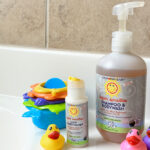Look alive! It's National Eye Health and Safety Month
As you stare into your wee one’s eyes admiring just […]

When baby enters the world, she doesn’t exactly see a bright and shining place. A newborn’s eyesight has been estimated to vary from 20/200 to 20/400, but this will improve to around 20/50 within the first year of life. If it doesn’t, your little Einstein may require glasses by her second birthday—just get the plastic frames!
But before you ever leave the hospital, make sure your bambino gets her eyes checked. 1 in 10 infants are at risk for undiagnosed vision problems, so baby’s first official eye exam should occur between six and twelve months, where the optometrist will check the structure of the eye, movement and alignment. Potential problems munchkin could face are cross eyes, amblyopia (lazy eye), cancer, nearsightedness or farsightedness.
To help proper sight development, you want to make sure baby gets plenty of lutein in her diet. Lu-what? you may be wondering, but you, mama, are actually the best source of this eye-protecting nutrient. Lutein is found naturally in colostrum and breast milk, as well as in spinach, corn, eggs, squash and apples. This antioxidant concentrates in human eyes to prevent oxidative damage and absorb harmful light. But in babies, lutein also works in the brain to help their auditory, memory, problem solving, motor function and visual processing systems develop.
Studies are now showing that focusing on your child’s eye development early on may prevent some health issues down the road. Today, 10.4 million children are diagnosed with ADHD (more than ever before), and kids with behavioral disorders struggle with symptoms such as short attention spans, irritability while doing homework, motion sickness, and emotional or developmental immaturity. These signs are all written off as ADHD, but they are also signs of something else—a potential vision problem. According to the American Optometric Association, one in four children has a visual problem that affects their ability to learn. The result of this study? The ADHD “epidemic” might not be widespread after all.
Even the healthiest eyes in the world are still at risk for safety issues. Items in your home are the main cause of eye injury, with toys actually being the most dangerous. And when it comes to being outside, make sure your babe rocks the sunglasses. If it’s sunny enough for you to be wearing tinted lenses, the little one definitely needs them too—her eyes allow for 70% more UV rays to reach the retina, and currently, only 23% of parents buy sunglasses for their little star.
There’s a great, big world to see out there, so make sure your tyke is prepared. With preventative care, regular checkups, and some diet and lifestyle choices, healthy eyes are just a blink away!







